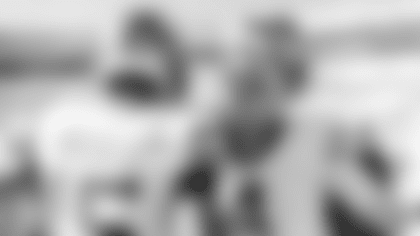This is the fifth story in Real Football Services' offseason series, a preview of possible Jets selections during the three days of the NFL draft from April 26-28:
Free agency opened with a flurry, and the amount of guaranteed money being thrown at players was astonishing to say the least. That left teams like the Jets and Steelers, who don't have a lot of room under the salary cap, standing on the sidelines a bit.
The Green & White did enter the fray this week with some signings aimed at addressing their immediate needs, but they still have plenty of opportunities in the draft to bolster the roster, which will make for some busy days at the Atlantic Health Jets Training Center in the coming weeks.
As the free agency signings begin to slow to a more manageable pace, and Wednesday's trade for Tim Tebow dominating the headlines, it's time to look ahead to what lies ahead in the draft for the Green & White. Even without the fourth- and sixth-round selections lost in the Tebow trade, the Jets could still find some impact players who can contribute right away. At this early stage of the game, it's hard to predict selections, but here's a look at some potential options for each of the Jets' picks.
Round 1 (16th Overall)
From day one of the offseason the Jets' first order of business has been to find an impact pass rusher. Rex Ryan's defense needs a guy who can dictate protections to the offense and make opposing coordinators account for him. At this point it looks as if only 4-3 teams Tampa Bay, Seattle and Philadelphia are lined up in front of the Jets with a need at OLB. But be wary of Bill Belichick, who is holding two first-rounders and could be moving up to snatch a pass rusher himself.
It's feasible that a player like Melvin Ingram could fall, but it's not likely. His stock continues to rise and he could potentially be one of the first six or seven players off the board. Still, the Jets will have their pick of players like Illinois' Whitney Mercilus, Alabama's Courtney Upshaw, Nick Perry of USC and Zach Brown of North Carolina, who were all productive players in school and have shown the skill set to excel as standup rushers.
Though the Chaz Schilens and LaRon Landry signings don't completely end the Jets' search at wide receiver or safety, it does lessen the urgency of filling those spots. Regardless, the Jets could find themselves staring at receivers like Notre Dame's Michael Floyd or Kendall Wright of Baylor. With over a dozen WRs already signed in free agency, there won't be as many teams looking for a receiver early in this draft, which means anyone who's name isn't Justin Blackmon could be in full-slide mode.
Alabama's Mark Barron is the only safety in this draft with a first-round grade, and though there aren't many impact safeties worthy of a first-round pick historically, Barron fills a big need for a Jets team that has seen Jim Leonhard finish the last two seasons with injuries. The team should probably be looking to upgrade Eric Smith's position as well, and while Landry may be one of the best in the league at his position when healthy, injuries have plagued him in recent seasons. Barron is a ballhawk, a textbook tackler, instinctive in coverage and strong in run support.
The last area the Jets will have to look at here is the offensive line. The right side needs help, and Kansas City's recent signing of Eric Winston takes the Chiefs out of the tackle business for the moment. Arizona could still be in the market for a LT like Stanford's Jonathan Martin, but that could leave Iowa's Riley Reiff as the slider. Still considered by some to be the second-best tackle in the draft, Reiff's strengths seem to be geared more toward that of a run-blocking right tackle.
Conclusion: Of course things will change, but right now it's hard to envision the Jets passing on a proven pass rusher. Mercilus is a high-effort guy who recorded an NCAA-leading 16 sacks last season but is only a one-year starter. Upshaw is a natural pass rusher who has played both as a pass-rushing DE and a 3-4 OLB, and Perry has 21½ career sacks. He doesn't possess ideal measurables for a 3-4 OLB, but his quickness, tenacity and nose for the backfield could allow him to overcome that.
Round 2 (47th Overall)
This could be the place where New York addresses its O-line needs. Keep an eye on the Wisconsin tandem of C Peter Konz and G Kevin Zeitler. Both are experienced players with a ton of game experience.
Konz played center throughout his college career, but he is a powerful run blocker at the point of attack who is also athletic enough to pull and trap and could play guard or even right tackle. Plus, you have a guy who can step in and call out protections should Nick Mangold get injured again. Remember how that went, Jets fans? Smart, tough and versatile, he'd be a great pickup here, though some are now projecting him as a late-first-rounder.
Zeitler is the prototypical tough guy. A mauler in the run game, he is quick and agile in pass protection and a dependable, hard-working player. He may also end up being just outside the Jets' reach in the middle of Round 2, but with the depth of talent at the position in this draft, some teams could try to wait it out, giving the Jets options.
If they do miss out on both of those players, Iowa State's Kelechi Osemele (kah-LETCH-ee oh-se-MAH-lee) is described as being stronger than he is big — and he's 6'5", 333!! Former Jets O-line coach Larry Beightol would have tabbed him "Roadgrader II" after Dwayne White. He's an aggressive pass blocker, a destructive run blocker in tight quarters, and is smart (three-time Big 12 Academic Honor Roll) and versatile, having played multiple positions along the line.
Wide receiver is another need that could be addressed here. South Carolina's enigmatic Alshon Jeffery is coming off a down year, but measured in at over 6'2" and 216 pounds at the combine. Concerns about maturity and work ethic will keep some teams away, but his size and big-play ability may be worth a look in Round 2.
Wake Forest's Chris Givens is a smaller, elusive receiver who is a polished route runner and a viable deep threat. Others who could be under consideration here include LSU's Reuben Randle, Georgia Tech's Stephen Hill, Mohamed Sanu of Rutgers, and the son of former Jet Al Toon, Wisconsin's Nick Toon.
Conclusion: The better value at this spot amongst the Jets' need positions is at OL. With a deep draft class of guards and tackles and a rash of O-line signings in free agency, a good player could fall to the Jets here and help immediately address their issues up front.
Round 3 (77th Overall)
The Patriots have changed the game with the way they use their TE tandem of Aaron Hernandez and Rob Gronkowski, and teams like the Jets have to figure out how to cover them twice a year. In a draft class that is weak in safeties, Boise State's George Iloka is an athletic and instinctive player who shows a willingness to give up his body in the run game, has the ability to play in both man and zone schemes, and can drop down and play in coverage against TEs, RBs, or in the slot in three-wide sets. He had a great week at the Senior Bowl, and though he needs to get bigger and stronger, that's easily fixable in today's NFL.
It wouldn't surprise us to see the Jets go with two offensive line men early in this draft. Bobby Massie of Ole Miss started 29 games at RT, is strong and fundamentally sound with long arms and big hands. He has plenty of physical ability and his initial quickness is impressive, but there are some concerns about work ethic that will have to be answered.
Another option could be at RB. Again, depending on where the runs occur on different positions, it is not completely out of the question that a player like Washington's Chris Polk could be available for the Jets here. A physical runner who doesn't go down on initial contact, Polk has been extremely productive, rushing for nearly 4,000 yards in three seasons, is a viable receiving threat out of the backfield, and is a finisher near the goal line (15 TDs in 2011). Though he has had surgery on his shoulder twice and had his knee scoped once, he hasn't missed a start in two years. We're not convinced that Shonn Greene can carry the load in the Jets running game, and Polk, at the very least, could serve in tandem with Greene early on.
Conclusion: With the Tebow trade costing two draft choices, the Jets have to make this one count, and while a player with Polk's production or another solid addition to the O-line would be nice, the safety spot is the way to go in Round 3 if Iloka is available. Landry and Leonhard, if he returns, are both injury risks, and the Jets need a safety who can support the run *and *cover.
Round 5
Until compensatory picks are doled out by the league office, we won't know exactly where this pick will be, but look for the Jets to try and add some depth to the O-line or find a playmaking WR or RB.
Arizona's Juron Criner isn't going to be the flashiest guy in the workout season, but the WR was extremely productive with over 150 catches and 22 TDs over the past two seasons. He's got the size (6'3", 224) and strong hands that NFL scouts look for and has the ability to gain yards after the catch.
Lucas Nix is an G/T out of Pittsburgh who shows great toughness and strength as an interior blocker. He's not the most athletic lineman, but he is a high-effort, lunchpail-type player who also has experience playing RT.
At RB, a player like Florida's Chris Rainey likely won't last until this point in the draft, but his versatility and 4.3 speed are characteristics the Jets could use. Dan Herron is more of a physical runner, tough and quick between the tackles. The former Ohio State Buckeye averaged 5.0 yards per carry as a senior.
Round 7 (Two Picks)
Tough to predict picks at this point, but a couple of players who would provide excellent value and special teams help this late in the draft include:
DE Malik Jackson, Tennessee: A USC transfer, he played mostly inside for the Vols but is best suited to playing DE in a 3-4 scheme. He is strong at the point of attack but needs to build lower-body strength.
RB Terrance Ganaway, Baylor: A thickly built one-cut runner who gets downhill quickly, he lacks the explosiveness to make plays much beyond the line of scrimmage. He could have value as a short-yardage/goal-line back given his 21 rushing TDs in 2011.
OLB Brandon Lindsay, Pittsburgh: A strong, violent player with natural pass-rush ability as shown by his 22½ career sacks. Though he played some DE in college, he's ideally suited as a standup pass rusher who may remind some scouts of a young, unpolished LaMarr Woodley.












